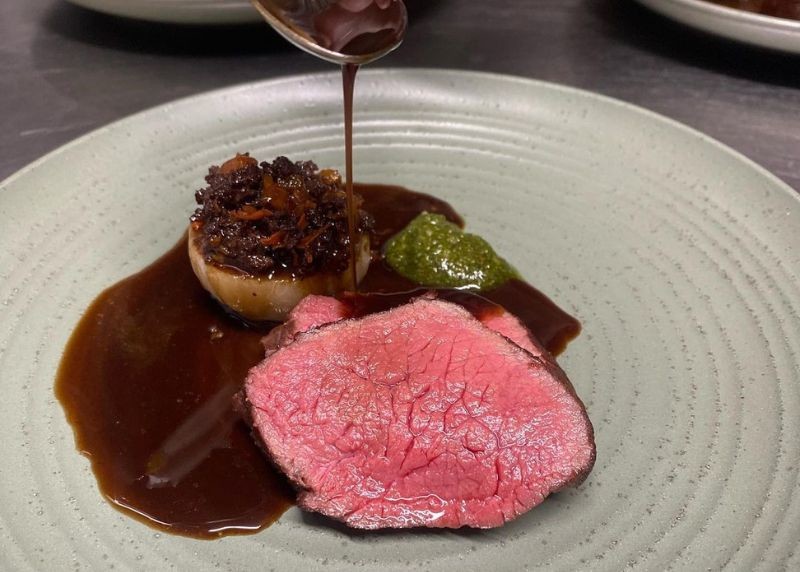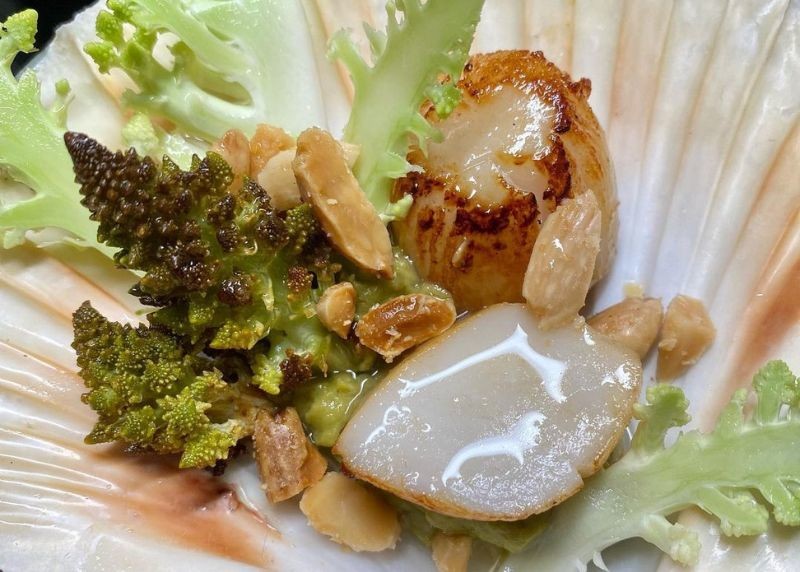Making restaurants economically sustainable is very important. Offering diners starter, main and dessert with six-plus choices per course is the absolute worst way to achieve this. These menus worked historically in an industry geared to diners who saw choice as non-negotiable, staff were plentiful and treated as disposable, apprenticeships were the absolute norm, ingredients were relatively affordable, seasonality meant little, utilities weren’t bankrupting-ly expensive, and kitchen operations were a clandestine secret known only to owners and chefs. Newsflash: this industry no longer exists.
Yet any follower of the current UK restaurant scene would be led to believe that another definition of sustainability is far more important: a restaurant’s zero-waste credentials. Let’s be clear on this: the single biggest cause of kitchen waste isn’t down to not knowing what to do with cauliflower leaves or carrot peelings, it’s three-course meals with choice.
Tasting menus haven’t just evolved to rip you off, bore you or massage chef’s ego. They have evolved because they reduce labour costs, waste and inefficiency, and allow a focus on quality. Small plates are not there to rob you of control or make you share un-sharable dishes – they are a very easy way to streamline labour costs and reduce waste. They make modern restaurants sustainable to run so diners can continue to enjoy them.
As do small plates. So why do so many diners have an aversion to small plates? What does small plates actually mean? Should it not be modern tapas? Sharing-style? Neither handle effectively sums up the approach but both do make me cringe. On paper, it’s the simplest thing in the world to show that little plates of food will come both in a sensible order and when they’re ready, but for diners used to the formality of starters and mains it’s a minefield of confusion. How many plates do I order? When will they come? Which will come first? Do I share each dish? Should I only order what I personally want? Do I have to discuss what I want with everyone else? To quell confusion staff must tell diners something about what’s on offer, yet mention the word ‘concept’ and guests instantly lose every ounce of willingness to participate.

As a restaurateur I know this style is what has made it possible to sell, for example, expensive premium fish for £14. I desperately want guests to understand and get the most from it. But this passion may not translate into the mouth of a team member who sees my concept as a kitchen trying to control things. Then, when a guest rightly feels affronted when chips come out ten minutes before any other food, pudding appears alongside a steak and hot food turns up long before the salad they planned to eat alongside it, goodwill is lost and negativity spirals. This is why taking the piss out of small plates is so easy and makes great column inches.
But this is not the fault of small plates, tasting menus, à la carte, or even carveries and greasy spoons – all these dining formats can be done well or badly. It’s down to the quality of a restaurant, not that restaurant’s conceptual choice, that defines whether it is good or otherwise. Everything else is just fashion. As a business model from a by-gone economic and social era, the structure and choice required by three-course a la carte dining makes operating difficult.
And consider the obvious impact of choice on waste. Fish is very expensive. Steak is very expensive. It is down to chance whether a restaurant, when choosing to invest in premium meat and fish, is able to sell it when choice is available. Worst case scenario: every diner orders the meat and if the restaurant is fanatical about its fish quality, it is going to have some very expensive waste on its hands. Now, in some restaurants, that fish can become a mousse, a brandade, a fishcake or be poached in a soup - dishes where, disguised by stronger flavours and processed textures, the day-old condition of a naked protein is no longer obvious. But top end restaurants won’t do this, they will throw fish away without thinking because it is past its best - best being a window of a day in some cases.
Tasting menus, by contrast, have many operational efficiencies. Unfortunately realising these is an uphill struggle for any restaurant because of knee-jerk preconceptions. It is a widely held view that the Prestige and Degustation menus of old were designed for snooty staff to plunder the pockets of diners. The thinking went along the lines that tasting menus are formal, intimidating, ponderous and unapproachable. They require a waiter to extend a pointy little finger at each one of thirty pointlessly tiny components until the described dish is as cold as each diner’s pulse. But for the upwardly mobile Waitroseian, they are also aspirational. They involve selling Michelin stars more than selling food because those who enjoy them want to eat Michelin stars and boast about it more than they want to eat food and enjoy it. Fans of tasting menus don’t care about high prices, lengthy hours spent at the table or miniscule suggestions of food tweezered into pointlessness, so there is no reason for restaurants to avoid such things as part of their tasting menu ‘experience’.

Now on occasion some of this is absolutely true. But it is also true that such a stereotype is lazy, dated and unfair on the large number of quality down-to-earth restaurants that adopt tasting menus because, operationally, they make a huge amount of sense.
Do you agree that minimising waste is important? Good, because from that point of view tasting menus are a dream. As long as allergens are identified in advance the kitchen knows exactly what is going to be sold and buys the produce to deliver it. No more, no less – an exact prediction of what is going to leave the kitchen with the minor unpredictability of cooking error, no-shows or customer dissatisfaction factored in.
The more obvious benefit of a reduction in dishes cooked is staff costs. Taking a kitchen from making 30 dishes to making 12 massively reduces required labour. There is a negative perception here because it sounds like tasting menus create redundancies, but for restaurants yet to open, staff cost is a variable to fix not a problem to solve. For restaurants already operating, where solvency is balanced against increased costs diners are unwilling to swallow, means ten jobs surviving over two jobs being cut, those two jobs should absolutely be cut. Not to make the owners rich, but to keep their livelihood intact, their staff in employment and their diners fed.
Staff cost is not just about the kitchen of course, and you’d probably imagine that more staff are required to deliver those ponderous dish descriptions and sell captive guests expensive wines. This is not always so. A la carte is worse from a staffing volume point of view. Structure makes things complicated – chefs and front of house need to communicate to deliver the expected progression of custom drinks, dishes and interaction each table expects. Doing this well for à la carte requires a written set of steps covering greeting, seating, water delivery, drinks order and delivery, cutlery, food order, bread service, starter service, starter clearing, mains cooking, mains delivery, checkback, troubleshooting, clearing, rest period, dessert order, cutlery, dessert delivery, coffee order and delivery, digestif order and delivery, bill, feedback, cleardown. Was that boring to read? Good – try implementing it in a team of 40 because that can get really boring. Three courses, all with a choice, all with a different process. Tasting is simply the same steps repeated six times with far fewer variables. It is easier to deliver because diners cannot change it.
If this lack of control frustrates you, how about we remove structure all together? Giving diners a structured three courses costs, perhaps, twice as much in staffing over a format that allows more stripping away of structure and formality than any other: small plates. Many diners have come to hate the idea of small plates but goodness me, from a restaurant’s point of view, being able to take unstructured orders and send food when it’s ready with no coordination is a godsend. It also has innumerable - but not immediately obvious - benefits to diners around variety, quality, minimising waste, flexibility, cost, seasonality, and informality. Pretty much every backstage benefit of a tasting menu can be applied to small plates (but without the fancy-pants stereotypes thank goodness), making it a system for the modern hospitality industry.
Get the latest reports from the coalface by signing up to The Good Food Guide Weekly here.








